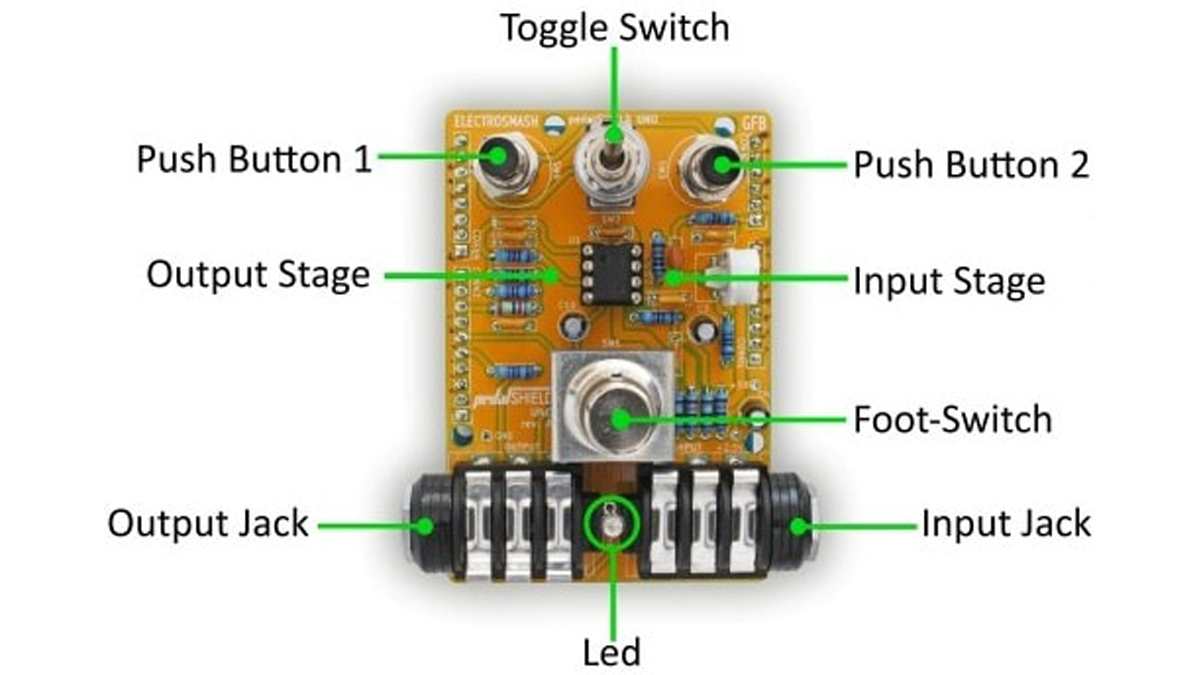This DIY Guitar Pedal project is for guitarists, hackers, and programmers that want to learn about digital signal processing, effects, synthesizers, and experiment without deep knowledge of DSP, electronics, or hardcore programming. pedalSHIELD UNO is a lo-fi, programmable guitar pedal that works with the Arduino UNO/Genuino UNO boards and is Open Source & Open Hardware. Learn to create your own programmable DIY Guitar Pedal and add effects such as distortion, fuzz, and more to your music. You can program your own effects in C/C++ or even use the ready-to-play effects from the ElectroSmash forum we have set up to support this project.
You can either get the PCB for this project on the ElectroSmash store or you can make your own on a breadboard by following the schematics in this tutorial. Check out this demo video of the Arduino DIY Guitar Pedal:
Required Materials
| Reference | Qty | Value | Description | Part Reference | ||||
| Capacitors | ||||||||
| C5,C2, C7, C8, C9 | 5 | 6.8n | ceramic cap | SR211C682MARTR1 | ||||
| C3, C6, C10 | 3 | 4.7u | electrolytic cap | ECE-A1EKA4R7 | ||||
| C1, C11 | 2 | 100n | ceramic cap | K104K10X7RF5UH5 | ||||
| C4 | 1 | 270p | ceramic cap | D271K20Y5PH63L6R | ||||
| Resistors | ||||||||
| R12,R13, R10, R9, R6, R4, R3 | 7 | 4.7K | Resistor, 1%,1/4W | MFR-25FRF52-4K7 | ||||
| R5, R7, R8, | 3 | 100K | Resistor, 1%,1/4W | MFR-25FRF52-100K | ||||
| R1, R2 | 2 | 1M | Resistor, 1%,1/4W | MFR-25FRF52-1M | ||||
| R11 | 1 | 1M2 | Resistor, 1%,1/4W | MFR-25FRF52-1M2 | ||||
| Others | ||||||||
| RV1 | 1 | 500K | resistor trimmer | 3319W-1-504 | ||||
| D1 | 1 | Led 3mm blue | blue led 3mm | SSL-LX3044USBC | ||||
| U1 | 1 | TL972 pdip-8 | op-amp rail-to-rail | TL972 | ||||
| IC Socket | 1 | dip 8 socket | socket dor dip8 | 1-2199298-2 | ||||
| SW1 | 1 | 3DPT footswitch | 3PDT footsitch | 107-SF17020F-32-21RL | ||||
| SW2 | 1 | Toggle switch | SPDT toogle switch | 612-100-A1111 | ||||
| SW3, SW4 | 2 | Pushbutton | off-on pushbutton | 103-1013-EVX | ||||
| Conn1,2,3,4 | 1 | 40 pin header | 2.54 pitch pin header | |||||
| J1, J2 | 2 | 1/4 Jack audio | stereo 6.35mm jack | NMJ6HCD2 | ||||
How Does it Work?

The system consists of three stages:
- The Input Stage: Amplifies and filters the guitar signal making it ready for the Arduino Uno ADC (Analog do Digital Converter).
- Arduino Board: Takes the digitalized waveform from the ADC and does all the Digital Signal Processing (DSP) creating effects (distortion, fuzz, volume, metronome…).
- The Output Stage: Once the new waveform is created, the signal is taken from the Arduino digital outputs (two PWMs combined) and prepared to be sent to the next pedal or the guitar amp.
Read More: How to Make a Programmable Guitar Pedal With Arduino!
